Contents
Introduction
Technological advancements in the 21st century have made the field of second language learning and instruction what Figueroa-Flores (2015) calls “more technology oriented” (p. 33). Indeed, the rise of language learning applications such as Duolingo, Memrise, and Babbel has made language learning more affordable and accessible to anyone with an internet connection and access to a computer or smartphone. One can now learn a language while “on the go” (Babbel, 2016, para. 3); individuals may bypass the long and arduous route to language learning via textbooks and language classes with these interactive, ‘gamified’ apps, which offer users a relatively fun and easy way to learn a new language. Certainly, the popularity of such apps, with their unique approach to language learning, has been attested to: Duolingo, for instance, boasts over 120 million users (Duolingo, 2016a)—a number that, according to founder Luis von Ahn, is far greater than that of the number of language learners within the US public school system (Codrea-Rado, 2014, para. 1).
In view of the above, it is worth exploring, therefore, the use of gamification as an emergent language learning strategy and its implications for second language acquisition. What makes apps like Duolingo so popular? How are they similar to, or different from traditional methods of language learning and instruction? Are they effective? This study seeks to answer these questions and more by examining the effect of gamified apps on second language acquisition; the ways in which language learning apps may be used in order to effectively maximise learning will also be highlighted.
Gamification: An Emergent Language Learning Strategy
Employing computer technologies in language learning and instruction is not new. Since the 1960s, the use of Computer-Assisted Language Learning (CALL) has enabled users to engage in a variety of online activities aimed at training and improving learners’ speaking, listening, reading, and writing skills—from drill-and-practice tasks to translation activities, and even web-based, speaker-to-speaker distance learning.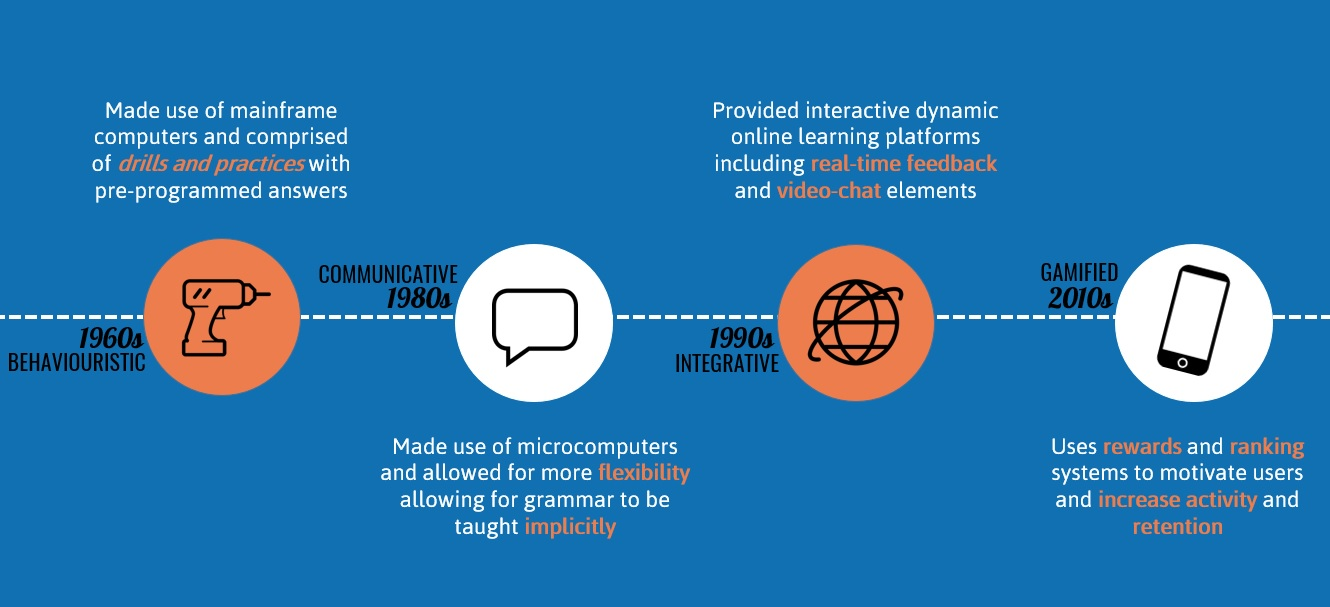
Figure 1. The history of CALL
With the advent of Web 2.0, the uses of CALL have been further developed to better engage the needs of language learners. Software focusing on greater interactivity, interoperability, and social collaboration have become the norm (O’ Reilly, 2005). Online learning platform italki, for example, offers users one-on-one video lessons with native speakers from around the world, while language learning app Busuu has written exercises corrected in real-time by native speakers (as opposed to pre-programmed answers in traditional CALL)—all of which are features that serve to mimic the dynamic, interactive nature of language acquisition. The rise of gamification as a new type of software design, therefore, may be seen as a product of these new user-centred technologies, combining the enhanced ‘social’ features of Web 2.0 with a game-like experience to further motivate and boost language learning.
Features of Gamification
Defined by Deterding, Dixon, Khaled, and Nacke (2011) as “the use of game design elements in non-game contexts” (p. 10), gamification has been employed variously in fields such as marketing, finance, and health, pioneering only very recently as a new type of strategy for language learning and instruction with the advent of Duolingo in 2011. The main objective of gamification, as highlighted by Deterding et al. (2011), is to “motivate and increase user activity and retention” via a “rewards and reputation system” (p. 9). Learning is thus meant to be fun—to quote Duolingo’s (2016b) manifesto, “It’s hard to stay motivated when learning online, so we made Duolingo so fun that people would prefer picking up new skills over playing a game” (para. 3). Within the context of language learning apps, these game-like features may be in the form of:
Figure 2. Some features of gamification in language learning apps
Evaluating the Effectiveness of Gamified Apps on Second Language Acquisition
As the principal focus of this paper is to assess the effectiveness of gamification as an emergent language learning strategy, parameters for evaluation accordingly need to be outlined and applied to our study. For this, we have turned to Shatz’s (2014) paper, which explores the role of three primary parameters in determining the effectiveness of a language learning strategy: efficiency, relevance, and motivation. As argued by Shatz (2014), these are most crucial for evaluating the overall effectiveness of any language learning strategy, a gauge that is important given that “it is in the interest of language learner to choose the most effective strategy for learning each aspect [of the language]” (p. 96-7). Through our evaluation, we aim to elicit the the strengths and weaknesses of gamification as a language learning strategy for the benefit of potential second language learners.
Efficiency
It goes without saying that many learners wish to acquire a new language as fast as possible, and gamified language learning apps market themselves as helping users to achieve just that. Duolingo, for instance, offers users the ability to learn a language in “just 5 minutes a day” (Duolingo, 2016c, para. 1), while Babbel’s promise to help individuals start learning “now” (Babbel, 2016, para. 1) stresses the immediacy—and ease—with which a new language may be acquired. With these apps, language learners can not only expect to acquire a language in the shortest time possible, but also to do so in a way that promises to be both fun and pain-free, as evidenced by Memrise’s slogan, “Learning, made joyful” (Memrise, n.d., para. 1).
Certainly, the gamified approach, with its employment of game-like features, may be seen as useful in helping learners achieve their desired levels of proficiency with minimal wastage of time and effort. The fun, bite-sized lessons offered by apps like Duolingo and Babbel are a key component in helping learners stay engaged and on-track. Given that learners’ levels of intake of new data tend to fall sharply after the first 20 minutes (Hewson, 1982, p. 271), it thus follows that new content and/or skills should be introduced in short bursts in order to maximise effective learning. Lessons offered across many of these apps are consequently limited to no more than 20 minutes; Duolingo users even have the additional option of setting lesson goals ranging from 5 to 20 minutes specific to their learning needs:
Figure 3. ‘Daily goal’ options for Duolingo users
Such an approach enables individuals to set aside a dedicated portion of time each day for focused learning, and the integration of language learning into users’ daily lives arguably makes the entire learning process less daunting. To further encourage users to log in consistently and to keep up to pace with lessons, points are accordingly awarded for attendance, which in turn contribute to user points for ‘levelling up’ to the next phase of lessons. The emphasis on learning iteratively and incrementally, therefore, enables individuals to reach their goals relatively quickly and easily: learning retention is boosted by the use of bite-sized lessons, users feel motivated by their ‘success’, and are consequently more likely to want to learn more, thereby speeding up the language learning process.
As noted by Hewson (1982), the “staging of skills” (p. 272) in a language learning programme is also important. Very often, learning a language can be a frustrating, long-drawn process, particularly if learners are thrown into an immersive language learning environment and expected to produce and use things he/she has never been taught explicitly to. The use of gamification in language learning apps accordingly helps to resolve such barriers to language learning by adopting a modular approach, where users work to progress through ‘levels’ akin to different stages of the language learning process. In Babbel, users are first trained to read in the target language via a series of word-recognition tasks, before progressing onto a range of speaking, writing, and translation-related activities. With the targeted staging of skills, language learners are thus taken from input to output relatively quickly, and with much less effort. In many of these apps, a “snowballing technique” (Mackey, 1965, p. 206) is also employed: each lesson typically focuses on a specific set of words or phrases through which users are taught various skills, with the familiarity of the content allowing users to continually build on and reinforce their learning, thereby enabling them to progress much faster. And as users must gain points—typically by completing lesson tasks accurately—in order to ‘unlock’ and advance to the next set of lessons, the game-like experience created within the app accordingly ensures that learners not only learn fast, but well too.
In addition to scaffolding material, the gamified apps also do well in offering a language learning experience tailored to the individual learner. Duolingo, for instance, employs the use of strength bars similar to that in games, which go from ‘full’ to ‘empty’ if more practice in a certain skill is needed. Users may accordingly zero-in on areas where more focus is needed; little time is wasted having to relearn a lesson from scratch.

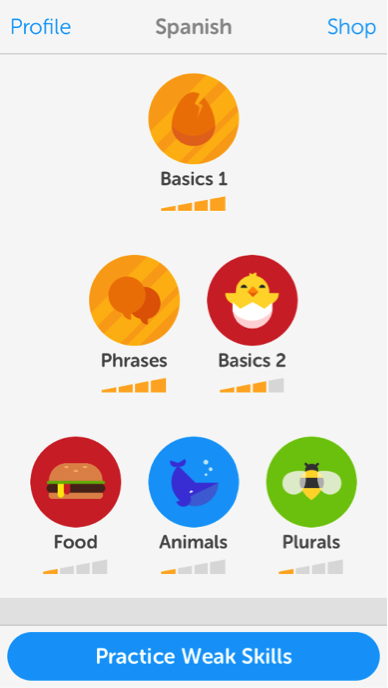
Figure 4. (Left): Strength bars that go from ‘full’ to ’empty’ if more practice in a certain skill is needed.
Figure 5. (Right): Users may review and practice their ‘weak skills’ via personalised vocabulary packs aggregated from user errors.
Given that points are earned to keep the bars ‘full’, users are additionally encouraged to continually sharpen their language skills, thereby enabling them to progress much faster. Further, users have the option to review and practice their ‘weak skills’ via the use of personalised vocabulary lists or flashcards. As these are aggregated from user errors made in lesson tasks, quizzes, etc., they are accordingly focused on the specific needs of learners, something which traditional methods of language learning and instruction (i.e. textbooks, in-class tutoring) arguably cannot provide. Since user attention is directed to where it’s needed the most, learning is consequently efficient and productive.
Relevance
As learners often have goals specific to their own needs, it is important that learning material offered in language learning apps is relevant and targeted to the needs of learners. A mismatch between learners’ goals and the material would accordingly mean wasted time and effort (Yasui, 2011). This is especially pertinent for individuals who learn primarily via apps, as they typically learn in isolation with interaction with native speakers in the real world, and may end up learning only general service vocabulary with little context if the material offered is not relevant. Below, we explore the twin aspects of relevance—contextualisation and personalisation—in relation to language learning apps.
Contextualisation
The language learning experience needs to take into consideration the context of learning and the aptitude of the learner. Within this frame, it must be noted that:
- Adult and child learners acquire languages differently. Adults learn better when the pedagogy used capitalises on the context of learning and individuals’ pre-existing cognitive and metalinguistic knowledge (Arnon & Christiansen, under review).
- Languages cannot be learnt in isolation. Without the experience of speaking and interacting with real native speakers, the language learning experience would accordingly be removed from the actual contexts of usage.
In many of the aforementioned language learning apps, an organic approach modelled on the naturalistic model of language learning is typically employed. Users interact with a minimalistic interface devoid of explanations or instructions and are expected to draw on pre-existing grammatical and morphological frameworks in answering questions. While this may arguably work for users learning a language that is closely related to their L1 (e.g. Spanish and English), expecting adult learners to naturally form a mental grammatical framework with minimal instruction in a language they have never encountered before may result in learning primarily through a “best guess” approach (Haburchak, 2014a), particularly as many of these apps offer only canned responses, with little specific or individualised feedback.
Figure 6. The app’s minimalist interface may result in learning primarily via a “best-guess” approach
Given that adult learners typically learn better through a ‘top-down’, guided approach, teaching through a grammatical or syntactic framework might prove to be a better method (Arnon & Christiansen, under review). Furthermore, due to their existing metalinguistic knowledge in the L1, adults have a heightened awareness of units in language learning. Expecting adults to match the sounds of words with pictures without an actual representation of the word itself (as many of the apps do) would invariably disadvantage individuals who learn best by reading and recognising units.
Divorcing the language learning experience from its real-world contexts would arguably result in difficulties in communicating when faced with real life encounters, owing to the lack of interaction with actual native speakers and exposure to different accents (Haburchak, 2014b). To mitigate this, Babbel uses recorded real-life dialogues which are integrated into the online lesson content; Rosetta Stone has live group video chats with a language tutor in which users may address any problems with specific to pronunciation or have their questions answered.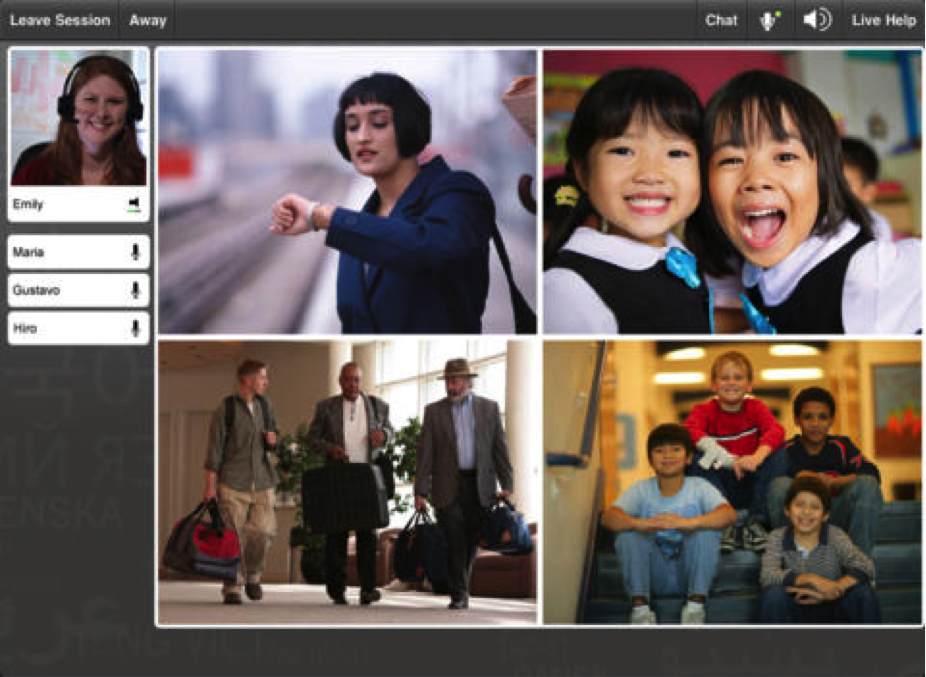
Figure 7. Live chat with native speakers on Rosetta Stone
In both apps, users are also exposed to native speakers through their interactions on social media and via the app. Although the use of online apps void of the ‘human touch’ cannot be compared to the level of contextualisation that a full language immersion programme can provide, we argue that the apps’ integration of a communicative-approach to language learning is definitely a step forward from the CALL programmes of the 1960s.
Personalisation
For learning to be relevant and effective, personalisation is also key—this is concerned with how customisable and closely-tied the app is with the individual user’s learning needs, goals, and background. Many of the apps do well in this area, taking into consideration of the user’s background via an initial placement test or proficiency measure of sorts in order to differentiate users for more targeted learning. In Babbel, for instance, users may opt for courses most suited to their needs: English for Business, for example, might be useful for someone seeking to pick up conversational English for a short business trip, while Oktoberfest German might appeal to tourists visiting Germany. In many of these apps, users are also allowed to ‘skip’ levels, and hence do not have to sit through lessons for things that they already know. Since the material is more relevant to the learner, he/she will naturally be more motivated to learn better and will better allocate resources to learning the specific language skills required.
That said, it must be noted that the apps are not entirely flexible in catering to every single user; these ‘differentiated’ offerings ultimately follow a standard, ‘one size fits all’ approach. So while the course content for learners of French for Native English Speakers would probably differ from that of French for Native Spanish Speakers for example, learner A and learner B of French for Native English Speakers would likely be subjected to the same course material despite having different goals and needs. Further, the employment of a modular approach means that learners would generally have to undertake the same language learning pathway: although the material is categorised into different sections such as ‘animals’ and ‘food’, users may only ‘unlock’ these lessons after they have finished the previous ones. While this is helpful for enhancing the effectiveness of acquisition, it also means that users might be wasting time and effort in learning things that are not useful, or of interest to them.
Motivation
Given the tremendous popularity of mobile gaming, with over half the U.S. population reported to be playing games on their phones at least once a month (Statista, 2016), the gamification model of language learning itself serves as a huge factor in creating motivation among users. Smartphone users who are already regularly using other gaming apps are certainly more likely to download gamified language learning apps. Thus, motivating users to download the app and start learning a language does not seem to be much of an obstacle for the gamified apps. However, it is in maintaining this motivation that the mechanics of the language learning systems must be examined, particularly since users’ perceptions of the effectiveness and relevance of language learning strategies have a significant impact on their motivation through the course of their learning (Shatz, 2014, p. 100).
Duolingo has done particularly well in maintaining the perception of the effectiveness of its platform, and in turn motivation. One example would be the conversion from the ‘hearts’ to the ‘power bar’ system. The initial ‘heart’ system saw each error resulting in the loss of one heart and the loss of all four hearts would necessitate repeating the level. An update in 2015 replaced the row of hearts replaced with a power bar:
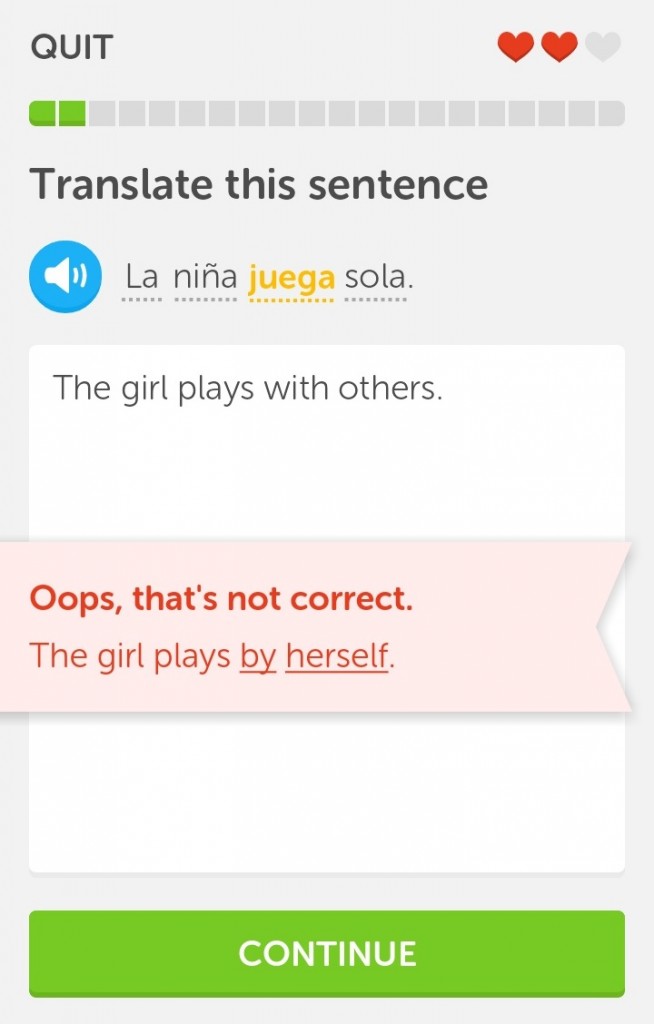
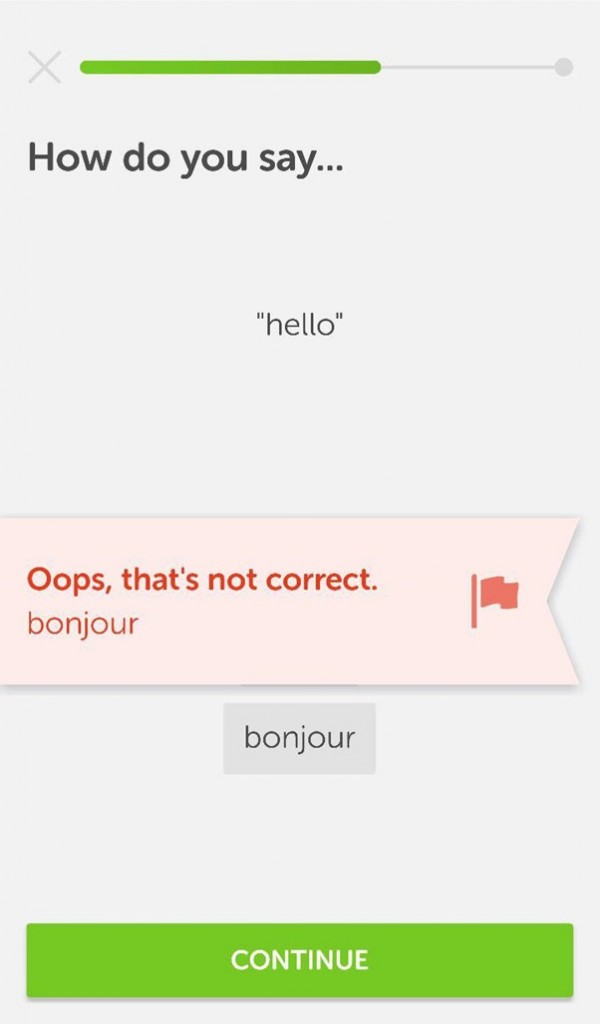
Figure 8. (Left): ‘Heart’ system: Each error resulted in the loss of one heart and the loss of all four hearts would necessitate repeating the level.
Figure 9. (Right) ‘Power bar’ system: The power bar grows with every correct answer and shrinks with each error.
This morale-boosting change was welcomed by Duolingo users who sang praises in the web discussion board (Smit, 2014). However, founder Luis von Ahn revealed that, similar to the popular gaming app Candy Crush, the Duolingo system is “rigged” in the early stages to produce easier questions, increasing the likelihood of right answers and the length of the power bar, thus hooking the users to play on (Velayanikal, 2016).
The system also effectively facilitates mastery-oriented and performance-oriented learning (Bucher, 2014). Mastery-oriented learning is achieved through supporting a sense of user competence through multi-level feedback, active revision options and level bypass options with users receiving copious information about how to improve their performance on the platform. Rewards such as “lingots” which allow users to access bonus material. Goal-setting tools to calibrate the intensity of the programme and progress-tracking using badges and “streaks” are combined to create a mastery-oriented experience (Karch, n.d.; Bucher, 2014). The system further simulates performance-orientated learning through the social rankings where users can compare their ‘experience (XP) scores’ against that of their friends on leaderboards.


Figure 10. (Left): User-earned ‘lingots’ may be used to purchase bonus materials such as flirting lessons and modules on idioms and proverbs.
Figure 11. (Right): Users may compete and compare with friends via a social leaderboard.
However, Duolingo still reports high ‘dropout’ rates. A Duolingo-funded study to measure the effectiveness of the app of use saw only 90 of the initial 196 participants sitting for the final test (Vesselinov & Grego, 2012). The relatively low number of users who complete the Duolingo course is likely due to the loss of motivation over long-term usage. This could be attributed to flexibility and utility of content, in which the Duolingo app is severely lacking.
We also note the app’s automatically produced sentences are structurally rigid as the production is aimed at emphasising specific grammar devices rather than at creating sentences useful in an everyday context (Bucher, 2014). This has resulted in many user reports of strange and unusable sentences produced by the app, for example: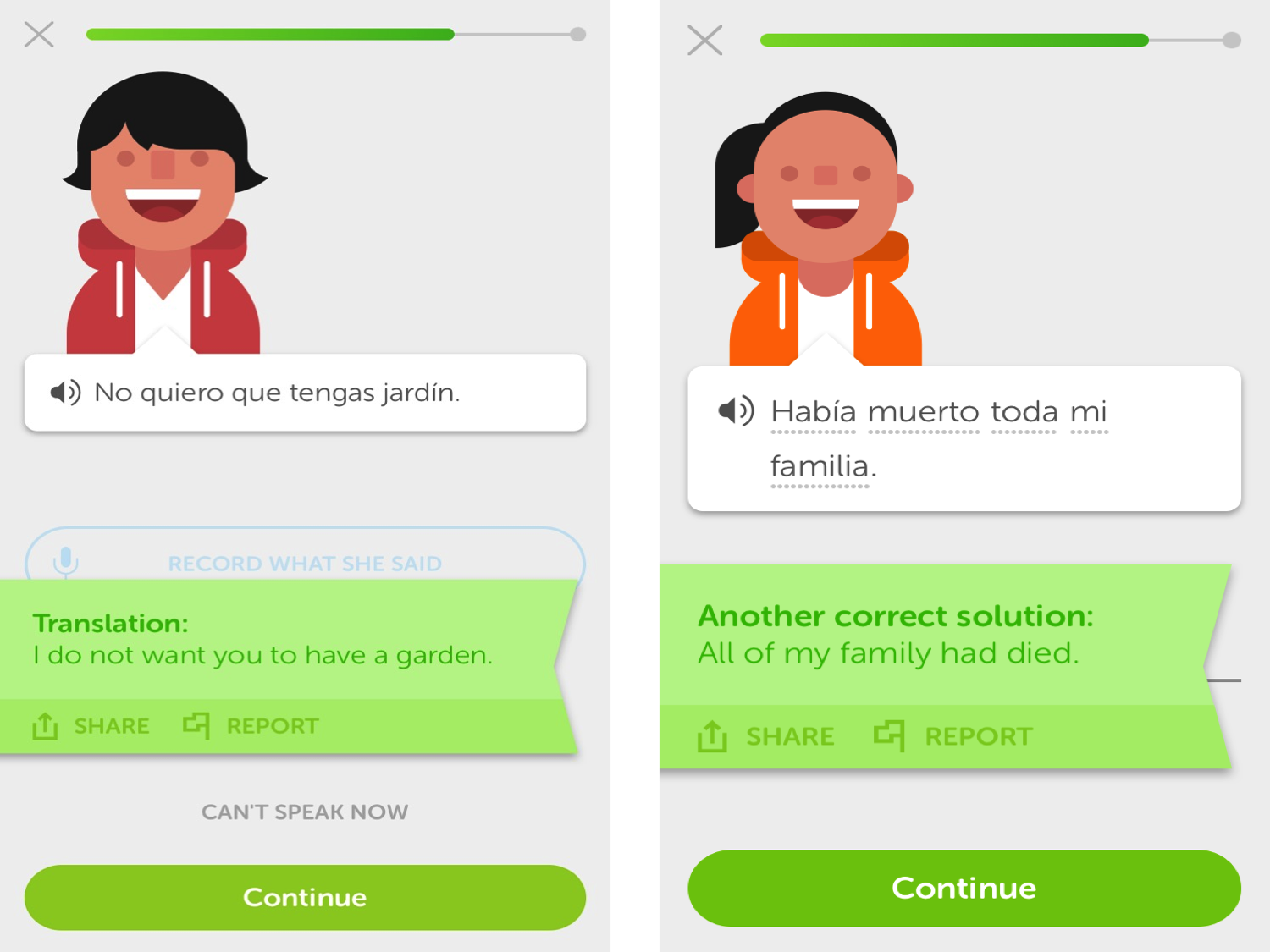
Figure 12. Some questionable sentences…
Moreover, users are unable to create free-form sentence and do not have flexibility in phrasing their answers. These problems may be limiting and frustrating to users especially once they reach higher levels.
Conclusion
Upon examining the gamified language learning apps through the parameters of effectiveness, relevance and motivation, our group has come to the following conclusions:
|
EFFICIENCY |
RELEVANCE |
MOTIVATION |
|
| Yay or Nay? |
Yay |
Nay |
Maybe? |
| Why We Think So |
|
|
|
At the end of the day, while gamified learning apps have many valuable attributes that help users enhance or catalyse their second-language acquisition, it cannot stand as the sole method of acquiring language, and is at best a complementary tool. Until artificial intelligence catches up to the more traditional or immersive teaching methods of teaching, the human touch and communicative aspect of learning still cannot be omitted in the acquisition of a second language.
First Created by Anna Saradha d/o R. Mohanadas, Rachel Lau Hui En, and Sharon Ng Yi Ling; AY 2016/17 Semester 1